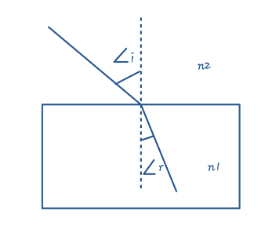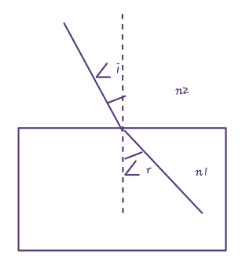
A glass slab made of material of refractive index
(A)
(B)
(C)
Answer
453.9k+ views
1 likes
Hint: Refraction occurs when a light wave, incident at an angle away from the normal, passes a boundary from one medium to another. And due to change in medium, change in velocity of light occurs.
Say, light travels from air into the glass, in which it moves slower, due to which wavelength of light must change too. And the light wave changes its direction. Also note that denser medium has higher refractive index as compared to rarer medium.
Complete step by step solution
Given, refractive index of glass slab
Refractive index of medium
(A)
i.e. the refractive index of glass slab is greater than that of medium. In this case, light ray will bend towards the normal as it enters the slab, because the speed of light decreases as it enters the denser medium.

(B)
As no change in medium occurs, so no bending or refraction occurs , and light ray travels as it is before entering the slab.

(C)
Here, light rays will bend away from the normal as this time; it enters into a rarer medium and in this, the speed of light increases.

Note
Refractive index is a value calculated from the ratio of the speed of light in a vacuum to that in a second medium of greater density. It is mostly applied for identifying a particular substance, confirming its purity, and measuring its concentration. It can be used also in determination of drug concentration in the pharmaceutical industry. Note that,
(1) When
(2) When
(3) When
Say, light travels from air into the glass, in which it moves slower, due to which wavelength of light must change too. And the light wave changes its direction. Also note that denser medium has higher refractive index as compared to rarer medium.
Complete step by step solution
Given, refractive index of glass slab
Refractive index of medium
(A)
i.e. the refractive index of glass slab is greater than that of medium. In this case, light ray will bend towards the normal as it enters the slab, because the speed of light decreases as it enters the denser medium.

(B)
As no change in medium occurs, so no bending or refraction occurs , and light ray travels as it is before entering the slab.

(C)
Here, light rays will bend away from the normal as this time; it enters into a rarer medium and in this, the speed of light increases.

Note
Refractive index is a value calculated from the ratio of the speed of light in a vacuum to that in a second medium of greater density. It is mostly applied for identifying a particular substance, confirming its purity, and measuring its concentration. It can be used also in determination of drug concentration in the pharmaceutical industry. Note that,
(1) When
(2) When
(3) When
Latest Vedantu courses for you
Grade 11 Science PCM | CBSE | SCHOOL | English
CBSE (2025-26)
School Full course for CBSE students
₹41,848 per year
Recently Updated Pages
Express the following as a fraction and simplify a class 7 maths CBSE

The length and width of a rectangle are in ratio of class 7 maths CBSE

The ratio of the income to the expenditure of a family class 7 maths CBSE

How do you write 025 million in scientific notatio class 7 maths CBSE

How do you convert 295 meters per second to kilometers class 7 maths CBSE

Write the following in Roman numerals 25819 class 7 maths CBSE

Trending doubts
Give 10 examples of unisexual and bisexual flowers

Draw a labelled sketch of the human eye class 12 physics CBSE

Differentiate between homogeneous and heterogeneous class 12 chemistry CBSE

Differentiate between insitu conservation and exsitu class 12 biology CBSE

What are the major means of transport Explain each class 12 social science CBSE

Franz thinks Will they make them sing in German even class 12 english CBSE




